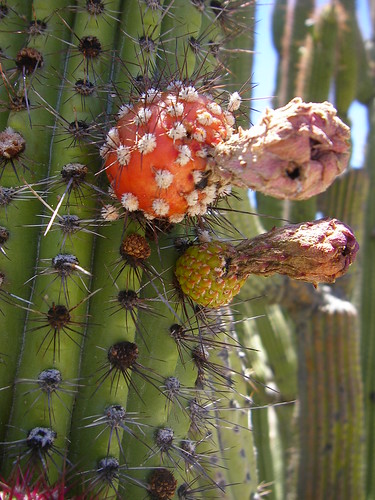 The Organ Pipe Cactus (Stenocereus thurberi) is a species of cactus native to Mexico and the United States. The species is found in rocky desert. Two subspecies are recognized based on their distribution and height. The Organ Pipe Cactus National Monument is named for the species.
The Organ Pipe Cactus (Stenocereus thurberi) is a species of cactus native to Mexico and the United States. The species is found in rocky desert. Two subspecies are recognized based on their distribution and height. The Organ Pipe Cactus National Monument is named for the species.Its English common name is derived from its resemblance to a pipe organ. It is locally known as pitaya dulce, Spanish for "sweet pitaya" or sweet cactus fruit.
The older plants produce three-inch (8 cm) funnel-shaped white flowers annually which are open at night and close by the morning and have a purple or pink tint to them. These usually grow during April, May, and June. The organ pipe cactus is usually pollinated by bats. The plant also produces fruit about the size of a tennis ball. Beneath the fruit's spiny exterior is red flesh that has been described as tasting better than watermelon.
This species is found mostly in Mexico, mainly in Sonora and southern Baja California. It is also known to the United States, but is much rarer, with the notable exception of Organ Pipe Cactus National Monument. The plant is predominantly found on rocky hillsides up to 3,000 feet (910 m) in elevation. It is sensitive to frost, so the species is rare in low desert areas, which can be more susceptible to frost. The plant is slow growing, and prefers well-drained soil and full sun. However, when in the seedling stage, it requires shade, and will grow beneath a "nurse tree". It will need this for several years until it grows an adequate root system, which is mostly in the upper 10 cm of soil.
There are two recognized subspecies, the type subspecies, thurberi, is much larger and occurs in southern Arizona, mainland Mexico, and Northern Baja California. The other is littoralis, which is much smaller and usually grows to around 10 feet (3.0 m). It occurs only in southern Baja California.
No comments:
Post a Comment